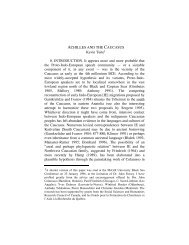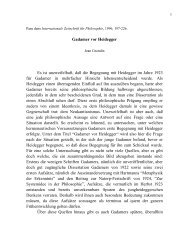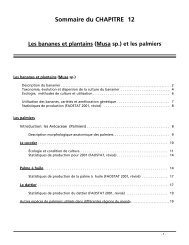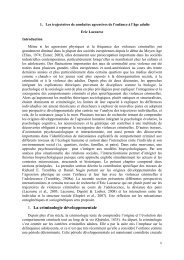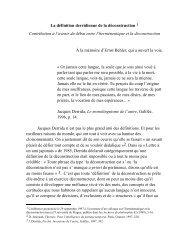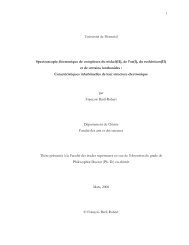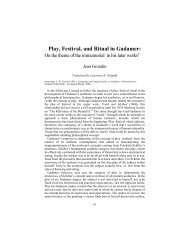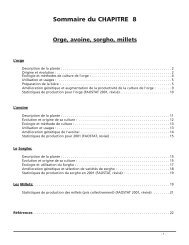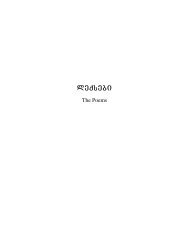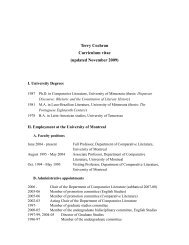Create successful ePaper yourself
Turn your PDF publications into a flip-book with our unique Google optimized e-Paper software.
VIOLET ON THE MOUNTAIN<br />
mourning the deceased hero Jabana are comforted with the thought that a bit of sunlight will follow<br />
him to the banquet in the underworld:<br />
His womenfolk were weeping, their faces bathed in tears.<br />
Do not weep for him, womenfolk: Jabana will not fare badly.<br />
Jabana went down to the land of souls, a ray of sunshine followed him;<br />
There he found the feasting-table spread with food and wine.<br />
20. Bzha dia chkimi (“The sun is my mother”). Source: MP 81. Recorded in Mingrelia by K’.<br />
Tatarishvili, ca. 1910. Note that, pace Francis of Assisi and his “Brother Sun and Sister Moon”,<br />
Georgian folklore identifies the sun as female and the moon as male. The pattern recurs in poem<br />
#32, “The woman Khwaramze.”<br />
21. Aguna (“Aguna”). Source: MP 113. Recorded in Ach’ara by T. Sakhok’ia in 1898. Aguna is the<br />
Georgian Bacchus, the deity of viticulture. His cult is observed throughout the grape-growing<br />
regions of West Georgia. This poem is to be recited in the vineyards or wine cellar on the first or<br />
second day of the new year. The accompanying rituals vary from one locality to another. In Guria,<br />
the family’s first guest of the year brings bread and the head of the pig served at the New Year’s<br />
dinner out to the vineyard. While striking the pig’s head with a stick, he intones the poem to Aguna<br />
[DGF I, 22]. In the province of Lechkhumi, the elder of the household calls on Aguna while pouring<br />
wine onto the base of a grapevine [MP 265]. Bakhvi and Ask’ana (second line) are neighboring<br />
villages in southern Guria, near the province of Achara .<br />
22. Tamar dedopal viq’av (“I was Tamar the Queen”). Sources: Ko 144; Go 135. Variants: Ko 257-<br />
258; PKh 61, RFl 259-267. Songs and legends about Tamar, who ruled from 1184-1218, abound in<br />
all parts of Georgia. It is not difficult to understand why. The reign of the woman the chroniclers<br />
called Tamar Mepe (“Tamar the King”) saw the culmination of her nation’s Golden Era. The<br />
Georgian crown exercised authority over a territory reaching from Samsun to Baku and south to the<br />
Araks River, including much of the North Caucasus, Armenia, Azerbaijan, and Turkey. Tamar’s<br />
subjects may have numbered ten million or more. “The knight in the leopard’s skin,” considered by<br />
Georgians to be the finest work ever written in their language, was composed in her honor. Within<br />
two decades after Tamar’s death, Mongol armies were sweeping through eastern Georgia, and so<br />
began a long period of decline and foreign occupation, leading up to the annexation of Georgia by<br />
the Russian Empire in 1801. While the exploits of Tamar the King, coupled with an understandable<br />
nostalgia for the cultural and political glories of her time, are sufficient to guarantee her a special<br />
place in the hearts of her people, there is another factor as well. The Tamar of folklore has the<br />
attributes of a deity, probably the result of an amalgamation of the historical Tamar and a pre-<br />
Christian celestial goddess [see SR 679-700]. The poem is in the form of an epitaph, in which the<br />
deceased monarch summarizes her achievements (no actual epitaph has come down to us, and<br />
Tamar’s grave has never been found). In addition to collecting tribute from human cities, she is<br />
credited with the conquest of the “Kajes,” a race of demons with magical powers frequently<br />
mentioned in Georgian folklore. Tamar is believed to have ordered the building of churches and<br />
castles throughout Georgia, and in every part of the country stand ancient edifices which, according<br />
to the local population, were built at her command. Many of these shrines and towers are located<br />
atop steep ridges. According to an account recorded in the province of Kartli, “at Tamar’s command<br />
the swallows brought sand and the cranes brought stones, and in this way she erected churches,<br />
monasteries, and fortresses on inaccessible mountains and cliffs” [Ko 375]. Numerous variants of<br />
this “epitaph” have been collected throughout Georgia [see RFl 259-267]. In some, Tamar is credited<br />
with the construction of particular churches (for example, the cathedrals of Ubisi and Manglisi,<br />
which in fact were built long before her time), and the list of cities she is said to have subjugated<br />
varies somewhat. Almost all versions mention her placing of boundary markers in the sea and<br />
drawing the dry land toward her (placing the land and sea under her dominion), and conclude with<br />
the lines “I, who accomplished such deeds, took nought but a nine-yard cloth” [that is, I took nothing<br />
nothing with me into the grave save my burial shroud]. Two versions specify that she drew her last<br />
127



